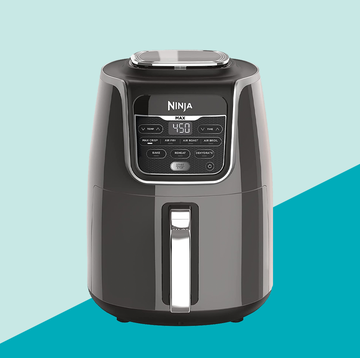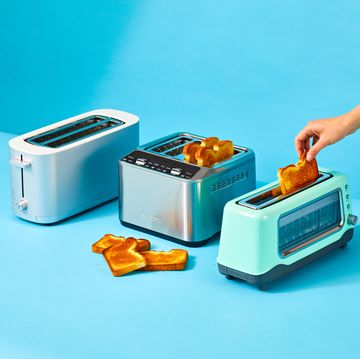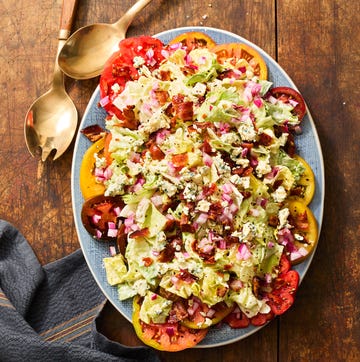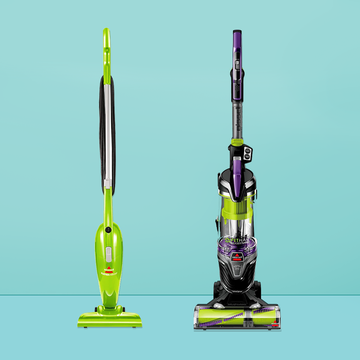As a food editor, I'm embarrassed to admit I don't own an air fryer. I have an oven — and a notable lack of counter space — and wonder if I really need another appliance to cook chicken or bake cookies. So what's the difference between an air fryer and an oven?
To help answer this question, I tapped Nicole Papantoniou, director of the Good Housekeeping Institute's Kitchen Appliances and Innovation Lab. For over a decade, the Lab and the Good Housekeeping Test Kitchen have tested air fryers and developed recipes specifically for them. While air fryer recipes can be adapted for the oven and vice versa, they require timing and sometimes ingredient adjustments. "The two devices are similar, but their mechanics are set up differently," says Papantoniou. Understanding their key differences can make or break your cooking — and help you decide whether you need both appliances.
How does an air fryer work?
"The main things that differentiate an air fryer from an oven are its heating system and size," says Papantoniou. Air fryers have a heating element and a large fan located on the top of their interior that circulates air while food cooks, encouraging even cooking and a crisp exterior. These fans typically operate at a higher speed than convection oven fans. The air fryer's small size also ensures a concentrated source of heat, so foods cook quickly. Air-fried food crisps up with little to no oil and excess grease drips through a perforated tray. Most air fryer baskets or trays are dishwasher-safe, making them easy to clean. Air fryer functionality is so beloved that it's now found in toaster ovens, full-size ovens and microwaves, with varying degrees of success.
How does an oven work?
Modern ovens have all kinds of capabilities, from dehydrating to steam cooking, but almost every oven can broil, bake and roast foods. Convection ovens have a fan at the back of the cooking chamber that circulates heat; traditional ovens do not have a fan. Ovens are much larger than air fryers so the heat is less concentrated and food takes longer to cook. To effectively crisp up foods, they must contain enough oil to encourage browning, cook for a long time or finish under the broiler, which offers a direct heat source.
Ovens typically take longer to heat up than air fryers, but they can cook a lot more at once. They can also accommodate foods that would never fit in an air fryer, like a sheet pan of cookies or a whole turkey. "Ovens have multiple shelves and are designed for use with cookware," Papantoniou adds. Perhaps the biggest pro of ovens? You probably already have one.
Is an air fryer just a tiny oven?
While the most obvious difference between an air fryer and an oven is size, there are other key reasons why an air fryer is not just a small oven. "Even if your oven has a convection setting, it’s still different because air frying usually cooks food from the top down," says Papantoniou. Ovens typically radiate heat from the bottom or both the top and the bottom. "Some ovens have added air fryer-like functionality, like faster fans, but our testing has shown that they don't work as well as air fryers," says Papantoniou. The size, heating element and fan discrepancies between these appliances mean that the air fryer is unmatched in its ability to cook food quickly and extra-crisp.
Fans of the air fryer also praise its ability to come to temperature quickly without heating the whole kitchen. Thanks to a fast circulation of hot, concentrated air, air fryers excel at cooking traditionally deep-fried foods, like golden-brown French fries, chicken nuggets, gooey mozzarella sticks and crispy wings. But they can also churn out baked goods, roast vegetables, cook juicy proteins and more. Air fryers can have different accessories than ovens, like dishwasher-safe baskets and trays, spits for rotisserie functionality and skewers for kebabs.
Can an air fryer replace an oven?
When cooking individual or smaller portions or reheating leftovers, using an air fryer makes much more sense than firing up your oven. If you're cooking food where crispiness is a goal, the air fryer is also a better choice.
But air fryers can't handle sheet pan meals, large holiday roasts or braises. If you regularly entertain or cook for the whole family, they may not be as helpful. Larger, air fryer toaster ovens come closer to oven functionality, but they're still much smaller.
The bottom line
Your air fryer can’t entirely replace your oven, but if you have the space and budget, it’s a worthwhile addition to your kitchen. If I ever get around to reorganizing my space to open up some counter or storage room, an air fryer is the first thing I'm adding to my cart.
Why trust Good Housekeeping?
Samantha MacAvoy is the assistant food editor in the Good Housekeeping Test Kitchen. She doesn't own an air fryer strictly for space reasons, but uses one frequently in the Test Kitchen and can speak to its powers. Air fryer salmon is the recipe that got her closest to purchasing the appliance.
Nicole Papantoniou is the director of the Good Housekeeping Institute's Kitchen Appliances and Innovation Lab and has been testing air fryers since before they hit the U.S. market more than 10 years ago. She uses her air fryer at least a couple days per week. She’s an experienced product tester and has reviewed air fryers, air fryer toaster ovens, ovens with air frying capabilities and air fryer microwaves.
Samantha (she/her) is the Senior Editor at Delish, where she edits the most-talked-about food news and features on the internet. In her previous role as Assistant Editor in the Good Housekeeping Test Kitchen, she taste-tested hundreds of products and recipes (tough job!). A graduate of Fordham University, she considers the kitchen to be her happiest place.














